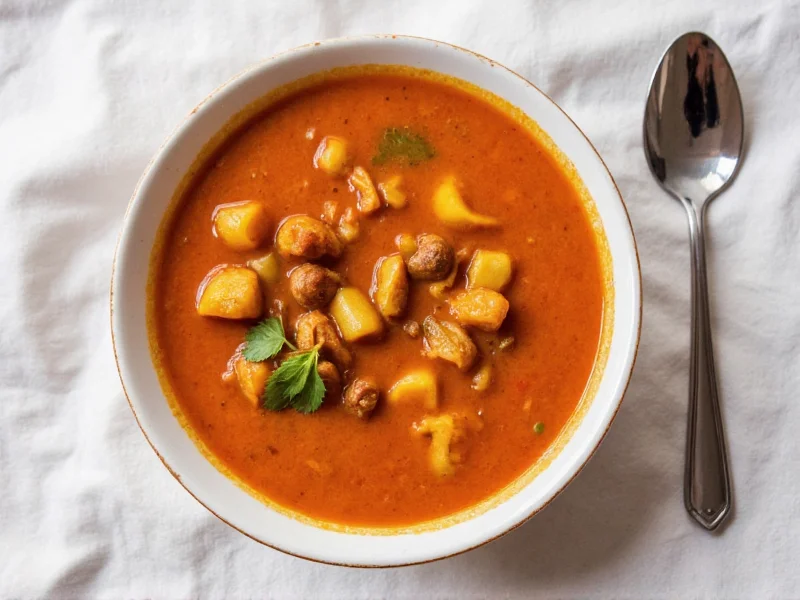Understanding the distinction between soup and stew matters for both home cooks and culinary professionals. While these terms are often used interchangeably in casual conversation, recognizing their technical differences improves recipe execution and enhances your cooking precision. This guide clarifies the specific characteristics that define each preparation method, helping you create authentic dishes that match culinary expectations.
Defining Soup: Liquid-Based Culinary Foundation
Soup represents one of humanity's oldest cooked foods, dating back to when early humans began using waterproof containers to boil water. At its core, soup is defined by its liquid foundation where the broth or stock serves as the primary component. The liquid-to-solid ratio typically exceeds 60%, meaning more than half the dish consists of broth. Ingredients in soup remain fully submerged and can be easily consumed with a spoon alone.
Soups generally fall into three categories: clear soups like consommé and broth-based preparations; thick soups including purées and cream soups; and specialty soups such as chowders and bisques. Each variation maintains the essential characteristic of having sufficient liquid to completely cover all ingredients. Soup preparation usually involves shorter cooking times, often under two hours, preserving more distinct ingredient textures.
Understanding Stew: Hearty Solid-Focused Preparation
Stew represents a more substantial preparation method where solid ingredients form the majority of the dish. Unlike soup, stew contains just enough liquid to cook the ingredients—typically 25-40% broth by volume. The cooking process involves larger chunks of meat and vegetables that maintain their shape while becoming tender through slow cooking, usually three hours or more at low temperatures.
What distinguishes stew most noticeably is its texture. When properly prepared, stew ingredients should hold together when lifted with a fork, rather than floating freely in liquid. The liquid component in stew serves primarily as a cooking medium rather than the main element to be consumed. Traditional stews like beef bourguignon, Irish stew, and goulash exemplify this hearty preparation style where the solid components dominate both visually and texturally.
Key Differences Between Soup and Stew
While both soup and stew involve combining ingredients in liquid and heating them, several specific factors determine whether a dish qualifies as soup or stew. These distinctions matter for recipe accuracy and culinary communication.
| Characteristic | Soup | Stew |
|---|---|---|
| Liquid-to-solid ratio | 60% or more liquid | 25-40% liquid |
| Ingredient size | Smaller, bite-sized pieces | Larger chunks (1-2 inches) |
| Cooking time | Typically under 2 hours | 3+ hours at low temperature |
| Texture | Broth flows freely | Thick, spoon stands upright |
| Serving utensil | Spoon only | Spoon and fork |
| Thickening method | Roux, cream, purée | Natural reduction, flour coating |
Common Misconceptions and Gray Areas
Several dishes create confusion in the soup versus stew debate. Chowder, for instance, occupies a middle ground with its thicker consistency but soup-like preparation. Bisques blur the lines with their creamy texture yet soup classification. Regional variations further complicate matters—what Americans call stew might be considered soup in other culinary traditions.
The critical factor determining whether a dish qualifies as soup or stew isn't the ingredients themselves but how they're prepared and presented. A tomato-based dish could be either soup or stew depending on the liquid content and ingredient size. Similarly, the cooking vessel doesn't determine the classification—dishes prepared in a Dutch oven could be either soup or stew based on their final consistency.
Practical Implications for Home Cooking
Recognizing the difference between soup and stew directly impacts your cooking results. When adapting recipes, adjust liquid content according to your desired outcome. For soup, maintain sufficient broth to fully cover ingredients. For stew, use just enough liquid to come halfway up the solid components, as evaporation during long cooking will reduce the liquid level.
Troubleshooting common issues becomes easier with this knowledge. If your stew seems too soupy, continue simmering uncovered to reduce the liquid. If your soup lacks body, consider adding a thickening agent rather than reducing liquid, which would alter the fundamental nature of the soup. Understanding these distinctions helps prevent recipe failures and improves your ability to follow authentic culinary instructions.
Historical Context and Cultural Variations
The distinction between soup and stew has evolved differently across cultures. In French cuisine, the separation remains quite precise, with specific techniques for each preparation. British culinary tradition often uses "stew" for heartier meat-based dishes regardless of exact liquid content. American usage has become more flexible, sometimes applying "stew" to any chunky preparation regardless of technical accuracy.
Historically, the difference emerged from practical cooking needs. Stews developed as economical ways to tenderize tough cuts of meat through slow cooking with minimal liquid—valuable when fuel was scarce. Soups evolved as efficient ways to extract nutrients from available ingredients, often using bones and scraps to create nourishing broths. Recognizing these origins helps explain why the liquid ratio remains the defining characteristic.











 浙公网安备
33010002000092号
浙公网安备
33010002000092号 浙B2-20120091-4
浙B2-20120091-4